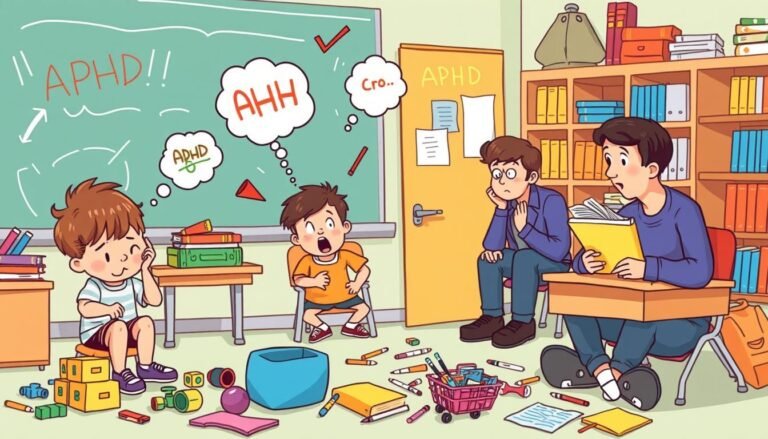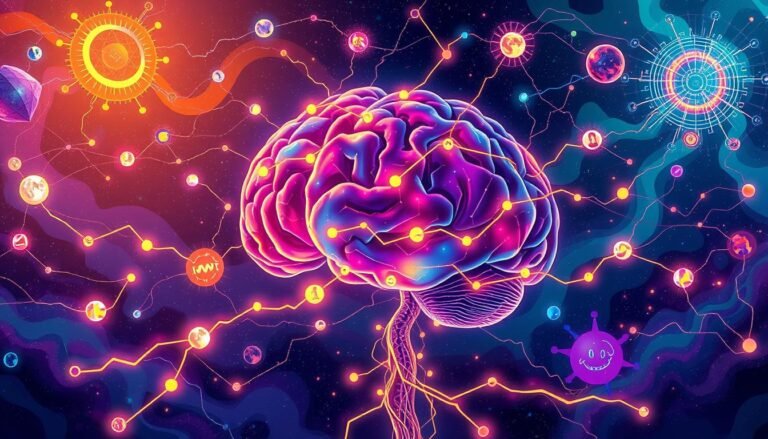Understanding Generalized Anxiety Disorder (GAD)
Ever felt like worry controls your life, keeping you always on edge? This might be more than just stress. Generalized Anxiety Disorder (GAD) affects millions in the U.S., but many don’t know the signs. Let’s dive into this common mental health issue and how it affects daily life.
GAD is a common mental disorder in the U.S. It often starts slowly, beginning in childhood or adolescence. But it can also start in adulthood. Women are more likely to have GAD than men, and it often runs in families.
Those with GAD worry too much about different life aspects. Worries can include job performance, money, and family health. To be diagnosed, these worries must happen often for at least six months.
Chronic worry and irrational fears are key signs of GAD. They can cause physical symptoms like trouble sleeping, muscle tension, headaches, and trouble focusing. These symptoms can really hurt a person’s quality of life and daily activities.
If you think you have GAD, getting help is key. Treatments include therapy, medication, and lifestyle changes. With the right care, many people with GAD find relief and learn to manage their symptoms.
What is Generalized Anxiety Disorder (GAD)?
Generalized Anxiety Disorder (GAD) is a mental health issue that affects many people. It’s marked by constant and intense worry about life’s many aspects, often without a clear reason. GAD can be hard to spot because it looks like normal worry and other anxiety issues like social anxiety and phobias.
Definition and Prevalence
GAD is more than just feeling a bit nervous. It’s about ongoing, uncontrollable anxiety that lasts for at least six months. Studies show that up to 20% of adults deal with anxiety disorders each year. GAD is twice as common in women as in men.
Distinguishing GAD from Normal Worry
While everyone worries sometimes, GAD is different. People with GAD find their anxiety:
- Is excessive and persistent
- Interferes with daily activities
- Is difficult to control
- Causes significant distress
GAD can lead to physical symptoms and may happen with other issues like panic attacks or obsessive thoughts. This makes it stand out from normal worry.
Impact on Daily Life
GAD can really affect a person’s life. It can mess with work, relationships, and overall happiness. People with GAD often face:
| Area | Impact |
|---|---|
| Work | Decreased productivity, difficulty concentrating |
| Relationships | Strain on personal connections, social isolation |
| Health | Sleep disturbances, physical tension, fatigue |
| Decision-making | Overthinking, indecisiveness |
It’s key to understand GAD for early help and effective management. If you’re always worried or anxious, getting professional help is crucial for a correct diagnosis and treatment.
Recognizing the Signs and Symptoms of GAD
Generalized Anxiety Disorder (GAD) shows through many physical and emotional signs. These signs can really affect how we live our daily lives. People with GAD worry a lot, more than usual, and it keeps them from doing things they normally do.
Insomnia is a big sign of GAD. It makes other symptoms worse and can make you feel tired all day. At night, they might lie awake worrying about work or their relationships.
Irritability is also common in GAD. People with it might get angry or upset easily. This can make it hard to be patient and can hurt their relationships.
Physical signs of GAD include muscle tension, shaking, sweating, and needing to pee a lot. These signs can be uncomfortable and disrupt daily life, adding to the distress.
| Emotional Symptoms | Physical Symptoms |
|---|---|
| Chronic worry | Muscle tension |
| Restlessness | Insomnia |
| Difficulty concentrating | Trembling |
| Irritability | Sweating |
| Sense of impending doom | Frequent urination |
Children and teens with GAD show symptoms in their own way. They might worry too much about school or being late. Spotting these signs early is key to helping them manage their GAD.
Causes and Risk Factors for Generalized Anxiety Disorder (GAD)
GAD comes from a mix of biological, environmental, and genetic factors. Knowing these can help people see their risk and find the right help.
Biological Factors
Brain chemistry is key in GAD. Imbalances in certain neurotransmitters can lead to irrational fears and panic attacks. Women are more likely to have GAD than men, which might be due to hormones.
Environmental Influences
Life events can start or make GAD symptoms worse. Traumatic experiences, big life changes, and constant stress are examples. Work stress, relationship problems, and too much social media can also raise anxiety. Even things like caffeine can make people worry more.
Genetic Predisposition
Studies show about 30% of GAD risk comes from genes. If a family member has GAD, you’re more likely to get mood or anxiety disorders, like social anxiety. This shows how important family history is in understanding GAD risk.
- Personality traits can make you more likely to get GAD
- Long-term health issues can also lead to GAD
- Having other mental health problems is common too
Knowing about these factors can help people see their risk for GAD. Getting help early and treating it can greatly improve life and stop symptoms from getting worse.
Diagnosis and Treatment Options for GAD
Getting a Generalized Anxiety Disorder (GAD) diagnosis means a thorough check-up. Doctors do physical exams to see if worry is linked to health problems. They might take blood or urine tests if they think there’s an underlying issue.
The Diagnostic and Statistical Manual of Mental Disorders (DSM-5) guides GAD diagnosis. It looks for anxiety symptoms lasting at least six months that cause a lot of distress.
There are several ways to treat GAD. Psychotherapy and medication are the main options. Cognitive Behavioral Therapy (CBT) is especially helpful. It helps people deal with constant worries and panic attacks.
Medications often used for GAD include:
- Antidepressants: Escitalopram, duloxetine, venlafaxine, and paroxetine
- Anti-anxiety medications: Buspirone
- Benzodiazepines: Used in limited circumstances
Changing your lifestyle is also key in managing anxiety. Regular exercise, enough sleep, relaxation techniques, and a healthy diet are important. It’s also best to avoid alcohol and drugs.
| Treatment Type | Examples | Effectiveness |
|---|---|---|
| Psychotherapy | Cognitive Behavioral Therapy (CBT) | Highly effective |
| Medications | SSRIs, SNRIs, Buspirone | Effective for many patients |
| Lifestyle Changes | Exercise, Sleep Hygiene, Relaxation | Beneficial for overall management |
While herbal remedies are sometimes used, more research is needed to see if they work for GAD. Starting treatment early and using a mix of approaches often leads to better results. This can greatly improve the quality of life for those with GAD.
Conclusion: Living with and Managing Generalized Anxiety Disorder
Generalized Anxiety Disorder (GAD) affects millions in the U.S., with women more likely to have it. Only 43.2% of those with GAD get help. It often goes hand-in-hand with other issues like social anxiety and depression, making a full treatment plan key.
Dealing with GAD can be hard, but it’s not impossible. Treatments include therapy, medication, and making lifestyle changes. Cognitive Behavioral Therapy (CBT) is very effective, sometimes even better than medication. Many find that mixing treatments works best.
Regular exercise, good sleep, and ways to reduce stress can help with symptoms like insomnia and irritability. It’s important to remember that GAD can be a long-term condition. Doctors suggest keeping on medication for a year after symptoms start to fade before slowly stopping it.
Seeing a healthcare provider regularly, at least every three months, is crucial. It helps track progress and adjust treatment plans as needed. With the right support and strategies, people with GAD can live happy, fulfilling lives and manage their symptoms well.
Source Links
- Generalized Anxiety Disorder (GAD)
- Generalized Anxiety Disorder: When Worry Gets Out of Control
- Generalized Anxiety Disorder – StatPearls
- Generalised anxiety disorder (GAD)
- Anxiety Disorders
- Generalized Anxiety Disorder (GAD): Symptoms and More
- Learn More About General Anxiety Disorder
- Generalized anxiety disorder – Symptoms and causes
- What Could Cause Generalized Anxiety Disorder?
- Generalized anxiety disorder – Diagnosis and treatment
- Generalized anxiety disorder: Learn More – Treatment options for generalized anxiety disorder – InformedHealth.org
- A Comprehensive Review of the Generalized Anxiety Disorder
- Diagnosis and Management of Generalized Anxiety Disorder and Panic Disorder in Adults
- Generalized anxiety disorder in adults: Management








